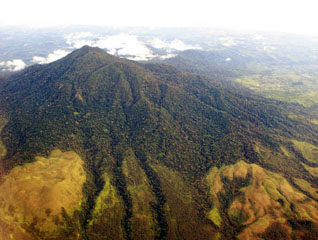Report on Seulawah Agam (Indonesia) — August 2010
Bulletin of the Global Volcanism Network, vol. 35, no. 8 (August 2010)
Managing Editor: Richard Wunderman.
Edited by Jen Fela.
Seulawah Agam (Indonesia) Minor tremor during April-August 2010
Please cite this report as:
Global Volcanism Program, 2010. Report on Seulawah Agam (Indonesia) (Fela, J., and Wunderman, R., eds.). Bulletin of the Global Volcanism Network, 35:8. Smithsonian Institution. https://doi.org/10.5479/si.GVP.BGVN201008-261020
Seulawah Agam
Indonesia
5.4472°N, 95.6555°E; summit elev. 1309 m
All times are local (unless otherwise noted)
This is our first report on Seulawah Agam, which has not erupted since a phreatic eruption in 1839. Beginning in April 2010, the seismicity increased at the volcano (table 1). However, visible signs of unrest were absent, although the volcano often is covered by fog.
Table 1. Types and numbers of volcanic earthquakes recorded at Seulawah Agam during April-August 2010. Background levels prior to increased April activity were not available. Courtesy of CVGHM.
| Month | Deep volcanic | Shallow volcanic |
| Apr 2010 | 66 | 70 |
| May 2010 | 55 | 121 |
| Jun 2010 | 53 | 83 |
| Jul 2010 | 46 | 76 |
| Aug 2010 | 80 | 99 |
On 1 September, based on the increase in seismicity, the Center of Volcanology and Geological Hazard Mitigation (CVGHM) raised the Alert Level to 2 (on a scale of 1-4) and restricted visitors from approaching the crater within a 3-km radius.
Geological Summary. Seulawah Agam, near the NW tip of Sumatra, is an extensively forested volcano with a small summit crater. It was constructed within the large Pleistocene Lam Teuba caldera, which also contains a smaller 6 x 8 caldera. The van Heutsz crater is an active fumarolic area on the NNE flank extending about 200 m downslope around 700 m elevation; it does not have the appearance of a volcanic crater. Additional geothermal areas are noted by Marwan et al. (2021). Sapper (1927) and Neumann van Padang (1951 CAVW) listed an explosive eruption in the early 16th century, and the CAVW also listed an eruption from the van Heutsz crater in 1839. However, Rock et al. (1982) found no evidence for historical eruptions. The Volcanological Survey of Indonesia also noted that although no reported eruptions have occurred from the main cone, the NNE-flank activity may have only been hydrothermal.
Information Contacts: Center of Volcanology and Geological Hazard Mitigation (CVGHM), Jalan Diponegoro 57, Bandung 40122, Indonesia (URL: http://vsi.esdm.go.id/).

